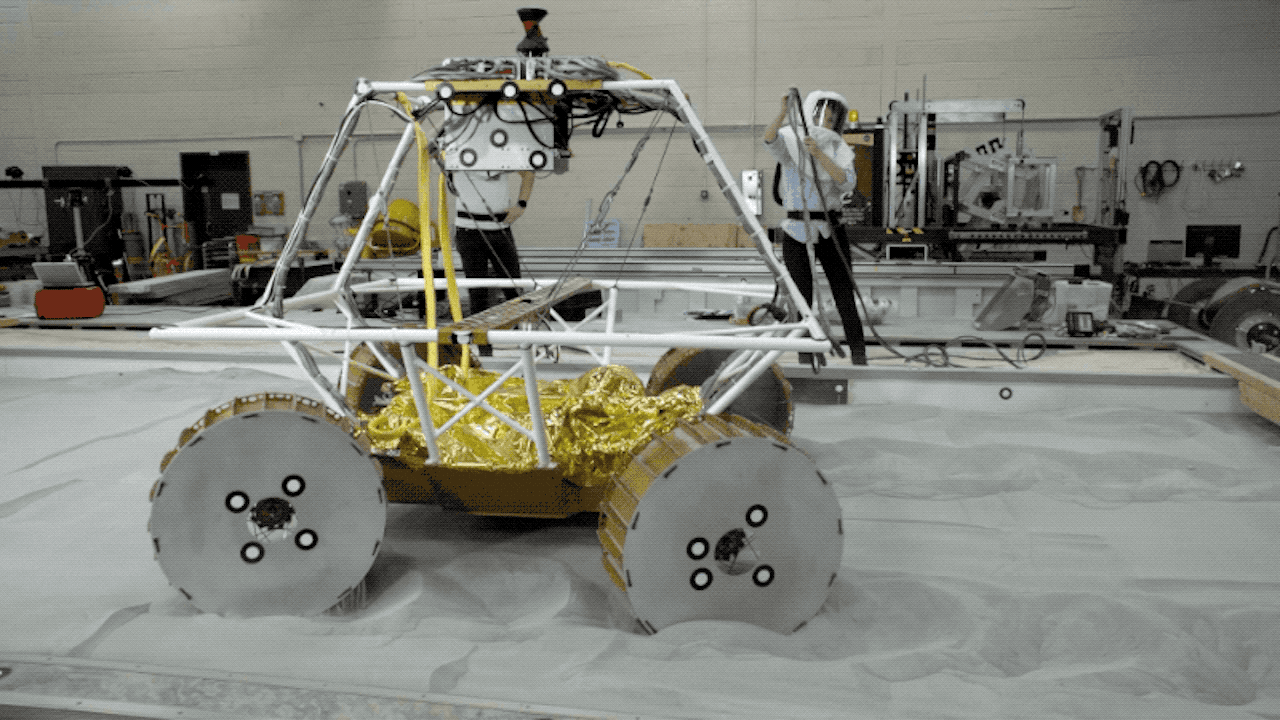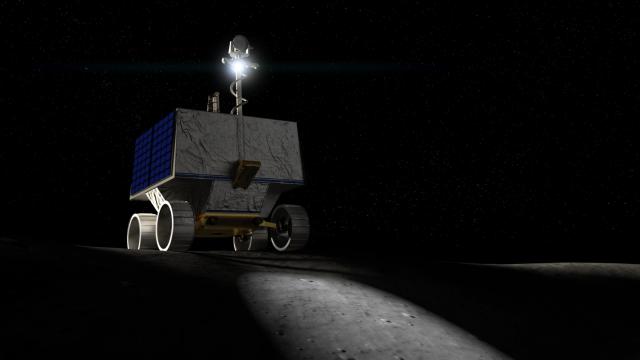Equipped with headlights and a suite of powerful instruments, NASA’s VIPER is poised to revolutionise our understanding of lunar water, and how much of it might be available to future explorers. Here’s what you need to know about the golf cart-sized rover, which is scheduled to reach the Moon in late 2023.
VIPER, or Volatiles Investigating Polar Exploration Rover, will map the location and abundance of water at the lunar South Pole, in a NASA mission that’s expected to last for 100 days. The four-wheeled, solar powered robot will search for water ice beneath the lunar surface and within shadowed craters.
“VIPER will be the most capable robot NASA has ever sent to the lunar surface and allow us to explore parts of the Moon we’ve never seen,” Sarah Noble, a program scientist for VIPER at NASA, said in a statement. “The rover will teach us about the origin and distribution of water on the Moon and prepare us to harvest resources 386,243 km from Earth that could be used to safely send astronauts even farther into space, including Mars.”
As part of the Artemis program, VIPER is meant to advance NASA’s goal of working sustainably on the Moon and elsewhere, and for the long term. Knowing where water is on the Moon, and how much of it might be available for use, will go a long way towards this lofty goal.
Pittsburgh-based Astrobotic won the contract to launch, transport, and deliver VIPER to the lunar surface in June of last year. Total mission development costs are listed at $US433.5 ($556) million, of which $US226.5 ($291) is allocated to the Astrobotic delivery contract, according to NASA.
The rover measures 2.5 metres tall and 1.5 metres in both length and width. VIPER is equipped with headlights, which is a first for a lunar rover. It’s going to need those lights to explore the shadowed, frigid regions of the Moon — including areas not exposed to sunlight for billions of years. The vehicle will need to withstand extreme temperature swings, the ultra-fine lunar regolith, and incoming cosmic rays.

Research from last year showed that water is all over the Moon, including areas exposed to direct sunlight and within special pockets on the surface, called cold traps, that are perpetually cast in darkness. Impact craters host many of these cold traps, making them important targets for exploration.
One of the most exciting aspects about VIPER is its specialised wheels and suspension system, which will allow the rover to overcome steep inclines and various surface types, and also dip down into impact craters.
“During normal operations, the rover will roll across the surface,” according to NASA’s VIPER info page. “Should it encounter extremely fluffy soil, VIPER can lift each of its wheels independently, almost like feet, and use them to dig into and sweep along the surface. This gives it a swimming-like motion capable of pulling the rover out of even very soft soils.”
Travelling at a maximum speed of 0.8 kph, VIPER will move in 4 to 8 metre increments, as directed by mission controllers on Earth. The rover will transmit its data back to Earth using an X-band communications system linked to the Deep Space Network. Back-and-forth communication will be a piece of cake; it takes signals less than 2 seconds to reach the Moon, as opposed to the nearly 20 minutes it takes signals to reach the Curiosity and Perseverance rovers on Mars.
VIPER will use four different instruments to do its work: the Mass Spectrometer Observing Lunar Operations (MSolo) instrument, the Near Infrared Volatiles Spectrometer System (NIRVSS), the Neutron Spectrometer System (NSS), and the the Regolith and Ice Drill for Exploring New Terrains (TRIDENT) hammer drill.
The TRIDENT instrument — a 1 metre percussive drill — looks quite interesting, as NASA explains:
The drill bit at the tip of the long drill string has carbide cutting teeth. These are harder than steel to maintain their sharpness and are similar to what you see on precision drilling or cutting equipment on Earth. That tip also carries a temperature sensor to take readings below the surface. Along the length of the drill string are those spiraling features familiar to any power drill user, called flutes. When TRIDENT is spinning, the flutes transport the drill cuttings up to the surface. A rotating brush sweeps the soil sample off the drill and into a chute, forming a neat pile on the ground where VIPER’s next set of instruments can analyse it.
Cool, right? Assuming all goes well, it’ll mark the first time since the Apollo missions that drilling has been performed on the Moon, and should it go as deep as intended, it’ll be the deepest drilling done on an alien world.
The probe is currently scheduled to launch to the Moon in November 2023, potentially pre-dating the planned arrival of Artemis astronauts by a year. No firm date has been given for the Artemis II mission, in which a crew of two will be delivered to the lunar surface.
VIPER actually reminds me of the NASA Surveyor probes — the first U.S. spacecraft to land safely on the Moon. These stationary probes were sent to the Moon to do scouting work in advance of the Apollo landings. A total of seven Surveyor probes were launched from 1966 to 1968, of which five landed successfully.
